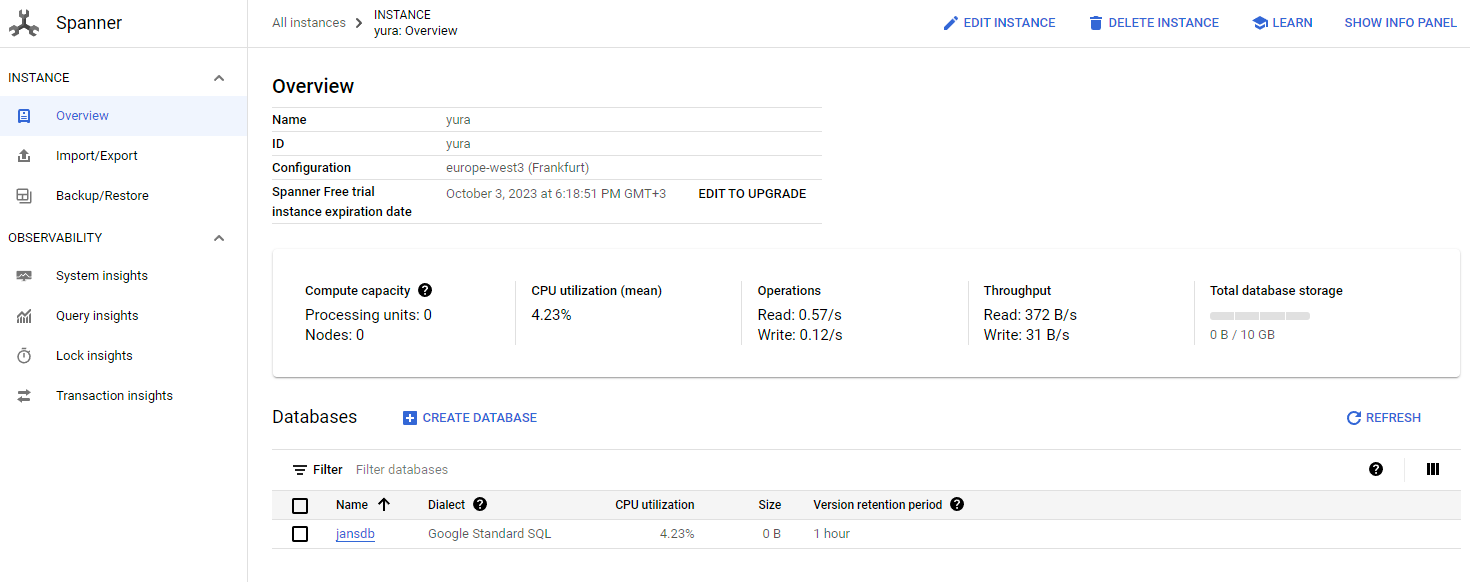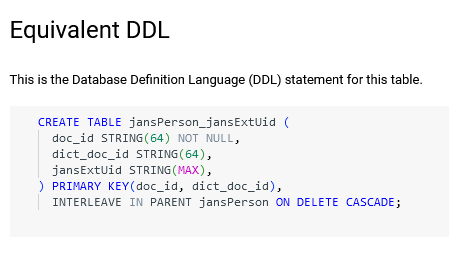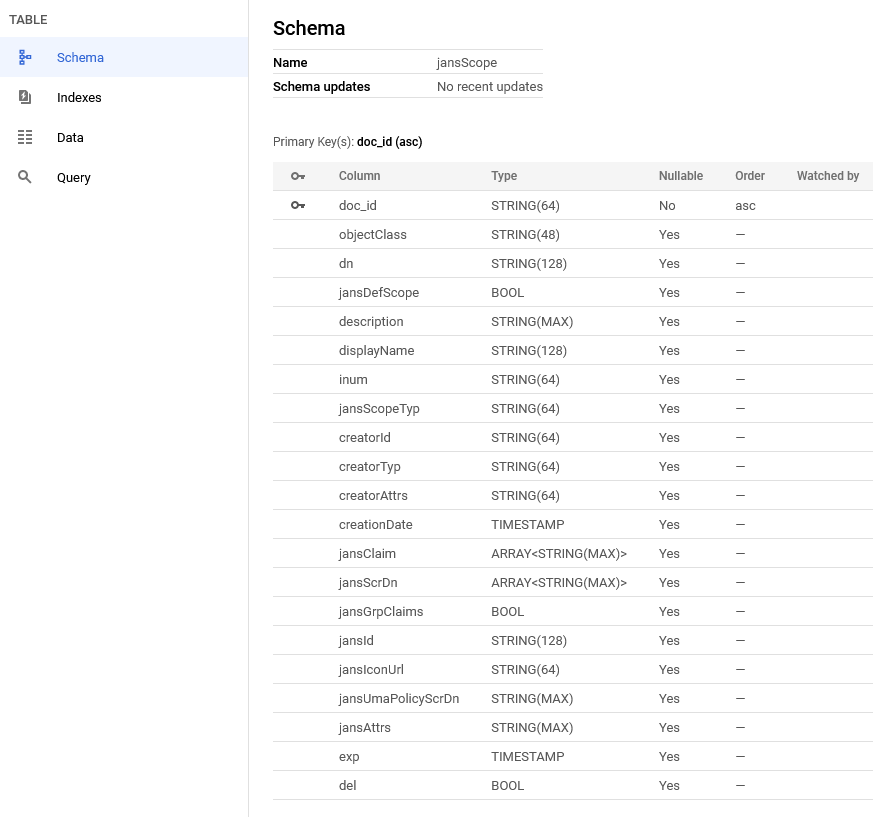Spanner ORM persistence layer#
The recommended Spanner version is 6.3x or newer. Setup supports both Spanner emulator and Spanner Cloud DB servers. Spanner emulator has many limitations and it's recommended only for development and testing. For case with Spanner Cloud the administrator should pre-create database and get Google credentials file. During install setup will prompt to enter project/instance/database and path to Google credentials file. After entering these details setup will check connection and start tables creation in specified DB.


During install setup generates default /etc/jans/conf/jans-spanner.properties for Jans applications
Configuration properties#
List of specific for Spanner default setting from jans-spanner.properties:
connection.project=jans-project
connection.instance=jans-instance
connection.database=jansdb
# Prefix connection.client-property.key=value will be coverterd to key=value
# This is reserved for future usage
#connection.client-property=clientPropertyValue
# spanner creds or emulator
#connection.emulator-host=
connection.credentials-file=/etc/jans/google_application_credentials.json
# Password hash method
password.encryption.method=SSHA-256
# Connection pool size
#connection.pool.max-sessions=400
#connection.pool.min-sessions=100
#connection.pool.inc-step=25
# Max time needed to create connection pool in milliseconds
connection.pool.create-max-wait-time-millis=20000
# Maximum allowed statement result set size
statement.limit.default-maximum-result-size=1000
# Maximum allowed delete statement result set size
statement.limit.maximum-result-delete-size=10000
The rest of properties are static for all other supported DB:
binaryAttributes=objectGUID
certificateAttributes=userCertificate
doc_id building rules#
In order to support transparency for end applications and allow data migration from one DB to another ORM requires DN attribute in each entry. This attribute it also uses to build doc_id. Here is example of this DN -> doc_id conversion:

doc_id is primary key. In order to build unique document identifier ORM uses another unique attribute DN. doc_id is last RDN value.
Generic tables structure#
Each table in jansdb Spanner schema follow next rules:
- one table for every LDAP objectClass
- has 2 mandatory column
DNanddoc_id - Index for primary key
- Interleaved tables with name pattern objectClass_propertyName

Multi-valued attributes support#
Spanner DB supports ARRAY attributes but at same time it's not possible to index them. This led to full table scan when query has filter with these attributes. Alternative for this is to use interleaved child tables. These tables can increase queries performance but in parallel with this this approach requires additional storage space for child table and index. Administrator should move only attributes which need ARRAY index to such tables.
ARRAY columns:

Interleaved columns moved to tables:


More details about interleaved tables, DB size and performance is in ORM Spanner module.
Data mapping rules#
ORM uses STRING / TIMESTAMP / INT64 / BYTES / BOOL / ARRAY

ARRAY it uses to store multi-valued attribute values. The generic format of such values is:
["value_1", "value_2", ...]
For user password field ORM on persist/update operations automatically create hash. On authentication ORM compares hashes.

To store attributes defined in java beans with @JsonObject annotation ORM uses STRING(MAX) column type.

Java example#
This example shows how to use ORM. It opens connection to Spanner DB and add user entry to it:
public static void main(String[] args) {
// Create Sql entry manager
SpannerEntryManager spannerEntryManager = createSpannerEntryManager();
// Create and fill user bean
SimpleUser newUser = new SimpleUser();
newUser.setDn(String.format("inum=%s,ou=people,o=jans", System.currentTimeMillis()));
newUser.setUserId("sample_user_" + System.currentTimeMillis());
newUser.setUserPassword("test");
newUser.getCustomAttributes().add(new CustomObjectAttribute("jansAddres", Arrays.asList("London", "Texas", "New York")));
newUser.getCustomAttributes().add(new CustomObjectAttribute("jansGuid", "test_value"));
// Call ORM API to store entry
spannerEntryManager.persist(newUser);
spannerEntryManager.destroy();
}
public static SpannerEntryManager createSpannerEntryManager() {
SpannerEntryManagerFactory spannerEntryManagerFactory = new SpannerEntryManagerFactory();
spannerEntryManagerFactory.create();
Properties connectionProperties = getSampleConnectionProperties();
SpannerEntryManager spannerEntryManager = spannerEntryManagerFactory.createEntryManager(connectionProperties);
return spannerEntryManager;
}
private static Properties getSampleConnectionProperties() {
Properties connectionProperties = new Properties();
connectionProperties.put("spanner#connection.project", "jans-project");
connectionProperties.put("spanner#connection.instance", "jans-instance");
connectionProperties.put("spanner#connection.database", "jansdb");
boolean emulator = true;
if (emulator) {
connectionProperties.put("spanner#connection.emulator-host", "localhost:9010");
} else {
connectionProperties.put("spanner#connection.credentials-file", "V:\\dev-gluu-cloud-platform-32136abdceb7.json");
}
// Password hash method
connectionProperties.put("spanner#password.encryption.method", "SSHA-256");
// Max time needed to create connection pool in milliseconds
connectionProperties.put("spanner#connection.pool.create-max-wait-time-millis", "20000");
// # Maximum allowed statement result set size
connectionProperties.put("spanner#statement.limit.default-maximum-result-size", "1000");
// # Maximum allowed delete statement result set size
connectionProperties.put("spanner#statement.limit.maximum-result-delete-size", "10000");
connectionProperties.put("spanner#binaryAttributes", "objectGUID");
connectionProperties.put("spanner#certificateAttributes", "userCertificate");
return connectionProperties;
}
More Spanner ORM examples is in this sample module.
Created: 2022-07-21